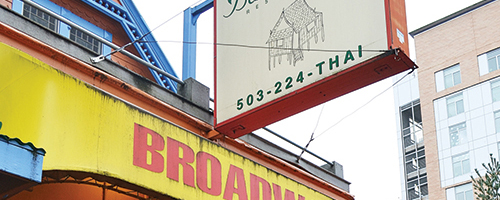On Monday afternoon, streams of sunlight gushed through the blinds of the Browsing Lounge of the Smith Memorial Student Union as Professor Steven N. Fuller gave a lecture, “Ein Jahr In Der DRR, A Year in East Germany 1984–85,” to a group of students and local German familiars.
Lecture and art installation paint East Germany as “brutal” place
On Monday afternoon, streams of sunlight gushed through the blinds of the Browsing Lounge of the Smith Memorial Student Union as Professor Steven N. Fuller gave a lecture, “Ein Jahr In Der DRR, A Year in East Germany 1984–85,” to a group of students and local German familiars.
With more than 30 years of personal experience with the Democratic Republic of Germany, Fuller painted a picture with words and slides of what it was like to be among one of the first 15 foreign students to study in Eastern Berlin after Germany was divided into the capitalist West and the socialist East by 96 miles of a 12-foot-high concrete wall.
As a Stanford undergraduate studying in West and East Germany during the 1980s, Fuller witnessed the “fabric of East Germany.”
Fuller expressed the harsh effects of the division between the West and East, from the economy and politics to the peoples’ perspectives.
“If you asked a West German about East Germans, their experience was incredibly limited,” Fuller said. “The East Germans had little knowledge of West Germans.”
Created to commemorate the 20th anniversary of the fall of the Berlin Wall, the lecture was a part of a film and lecture series that acted to support the Icons of a Border installation, a photography and sound-recording exhibit in the Millar Library displaying visible and invisible remnants of the wall.
Fuller told stories of crossing the closely patrolled borders of Berlin and being stalked by the paranoid East German state security officers. He remembered the “strange logic” of East Germans and waiting aimlessly in long lines to buy unnecessary goods that might never make it across the border for a year. Fuller discussed the oddities that East Germans had with regards to daily life, and the irony of soaring hard-liquor consumption and reading 60–80 books a year.
“The public sphere was a brutal, lonely, cold and colorless place,” Fuller said.
Fuller described living in a society with no community attitude and being forced to create a close-knit support network of friends. He quoted Max Weber’s “trickle down theory of resentment” and described how tight control from the top led to the continual oppression of people below.
Elke Rühl, a German language consultant from the Central Agency for Schools Abroad who attended the lecture, remembers the distance the wall created with her relatives who lived in the East.
“We had letters coming and going, and my grandmother always sent coffee,” she said, “but we never got to know them, unfortunately.”
Beate Hoffman, who is also from West Germany, said that as a young woman she never believed the West and the East would come together, and would be, at best, separate countries.
“I still believe it will take one to three generations before the differences between the countries will have a feeling of a united Germany,” she said after the wall fell.
Fuller said that the fall of the wall is “one of those historical moments defining a generation of people, like what the Kennedy assassination was for some people, and what 9/11 will be for your generation,” he said. “It was a defining event, and one of the most important dates in German history.”



